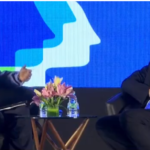- November 27, 2019
- Posted by: Shivani Chopra, CFA
- Category:BLOG, Careers, Events

Speaker: Mr. Sankaran Naren, ED & CIO at ICICI Prudential Mutual Fund
Moderator: Mr. G. Maran, Executive Director, Unifi Capital
Written by: Shagun Thukral, CFA
Mr. Sankaran Naren, CIO at ICICI Prudential Mutual Fund, spoke at the post lunch session at CFA Society India’s Value Investing Pioneers Summit in New Delhi.
Naren’s was an enlightening session as he spoke about his investment style, philosophy and learnings through the course of his long and illustrious career in the investment management. He covered a broad spectrum of topics ranging from essentials of investing, his contrarian style, understanding cycles, key metrics for stock picking, wealth creation and limitations of investing.
Naren started with the basics of investing which according to him comprised of – buying, sizing and selling. He made an astute observation – “if one was to look at available literature, 90% of it was focused on buying, when in reality more time should be spent on sizing as well as selling decisions”. He also shared a behavioural hack with the audience – since it is difficult to take a ‘sell’ decision, one should evaluate these decisions as a ‘switch’ – assuming one is always selling to buy something else. This makes it easier to take such decisions. Naren has often been associated with the Contrarian style of investing. He said that since he manages large portfolios, a contrarian style suits him well. Mutual funds get large amount of inflow in bull markets when other investors are shunning what is not popular. This gives him a chance to pick these investments at attractive prices and in large volumes. According to him, contrarian investors should be careful on leverage as wrong timing in a leveraged contrarian trade can prove to be disastrous.
Naren said that contrarian investing works best in cyclical sectors (as these sectors are prone to mean reversion). He also emphasised on knowing the counterview on the stock, having a grip on the intrinsic value of the stock and doing appropriate risk management.
Naren said that when it comes to investing, he believes in three things – Cycles, Charts and Common Sense.
He explained that markets go through cycles because of investors’ irrational behaviour. However, these cycles also give smart fund managers opportunities to buy and sell He also advocated the use of charts before a buy/sell decision for the primary purpose of understanding how many people have the same thought process, e.g. if many people are thinking like you, it may not be good trade as it would have already affected the price.
The next big learning shared by Mr. Naren was the importance of taking a cash call. Although cash is often considered a residual asset class, the importance of holding cash was highlighted during the 2007-09 period as the global financial crisis unfolded. Only those investors who had some cash could utilise the opportunity available and it helped them to recover quickly from the drawdown.He advised that if everything is expensive then invest in gold or cash. If everything is cheap, then keep nothing in cash.
Naren then moved on to discussing key metrics that he considers important while picking stocks. These included the trailing P/E, P/B, P/cash earnings ratios as well as market cap, balance sheet quality and IPO/QIP activity in the sector. Specifically, he felt that comparing the market capitalization of stocks, sectors etc had served him well in the past as it helped identify extremities in the market. He explained this with several examples.
In 2007, the market cap of DLF was greater than the entire pharma sector put together, indicating a clear sell in the stock in hindsight. In 1999, at the height of tech rally, the combined market capitalisation of Infosys and Wipro was 3x of combined market cap of some leading metals and cement companies. He even pointed out how currently (Sep ’19) market capitalisation of HUL was higher than combined market capitalisation of top 10 pharma companies in India.
For wealth creation, Naren follows the following framework (VCTS) : Valuation (the data)-Cycle (how others are behaving)-Trigger (the event)- Sentiment (the flows). Of these he believes that valuations are the easiest whereas identifying the trigger is the toughest (as these are not knowable and controllable). Ideally if the other three (VCS) are in place, one must act and not wait for the trigger.
Given his thought process and investment philosophy, Naren finds it difficult to buy high trailing P/E or high market cap stocks which at times leads him to miss growth sectors. He also tends to avoid stocks that have consensus among fund managers.
Naren then highlighted the key traits required in a person who wants to succeed in investing These include: 1) Time management 2) Thinking 3) Temperament 4) A habit of reading,
In conclusion, Mr. Naren shared some ‘truisms’ that budding investment managers may keep in mind. These were as follows:
- Hubris is a reality – use hybrid funds, credit funds, close ended funds and avoid leverage to deal with this
- No decision is also a decision
- There will be mistakes and it is not possible to get all calls right
- Money comes to a fund manager till he fails (Success leads to more inflows, which makes managing tougher and tougher till one fails)
- Nothing called consistency in performance, only in processes
- Forced buying or selling are good investment/disinvestment opportunities
The session was extremely well received and Naren went on to address several questions from participants as well. During the QnA , he stressed on the need to follow a transparent and responsible fund investing. He also advocated on being an ‘unemotional’ fund manager as it helps in taking key decisions like not giving buy calls all the time.The mutual fund industry is sometimes criticized on being over diversified but Naren cleared the air that diversification is a function of the size of fund one manages and the big mutual fund houses are bound to be well diversified. Lastly, the speaker opined that ” The challenge of investing is the ability to take a process and religiously follow it on a continuous basis”.
Link to complete presentation-S. Naren – Presentation


